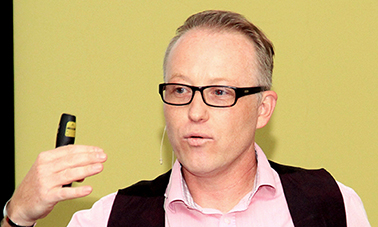
Dr Thierry Luescher, Assistant Director of University of the Free State Directorate for Institutional Research and Academic Planning, was one of the guest speakers at the first TEDxUFS event of the year on the Bloemfontein Campus. Here he is explaining where the #movements started, and how to change the way we think. Photo: Marli du Plessis.
|
The student protests, known as the #MustFall movements, started on 9 March 2015, when students protested in a well-rehearsed manner at the Cecil John Rhodesstatue at the University of Cape Town. After this protest, students all over South Africa started their own movements from #OpenStellies to #SwartsMustFall, the latter happening on the Bloemfontein Campus of the University of the Free State (UFS) in March 2016. But, as Dr Thierry Luescher, Assistant Director of UFS Directorate for Institutional Research and Academic Planning, says: “We shall soon run out of #MustFalls. Maybe it is time that we rise again.”
The first TEDxUFS was held on Friday 15 April 2016 at the New Education Building on the Bloemfontein Campus of the UFS. Dr Luescher shone light on the way we look at hashtag movements. At the conference, he was one of the guest speakers who shared their perspectives on the theme of #ImpossibleIsNothing. The others were Ndumiso Hadebe, and Fezile Sonkwane.
Changing angles
No matter what the issue, whether it is on a campus or not, the same reaction can be expected by all: they burn things to get attention. In retrospect, this is our political culture. This is what we have been told to do if we need answers. There is a much faster and cheaper way to attract people’s attention: the hashtag movements, says Dr Luescher.
Stop the fire
He argues that we should stop burning down buildings and vandalising properties. What we need is people with intellect to use their words. We, as students, have to take back our voice. We need to stop this self-pitying, and take a stand.
Students have the power to change lives. We would be able to reach as many as 1.4 million people with our tweets or instagram accounts. According to Dr Luescher, the time for violence has come to an end.